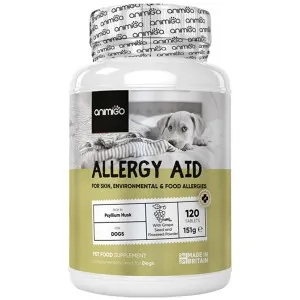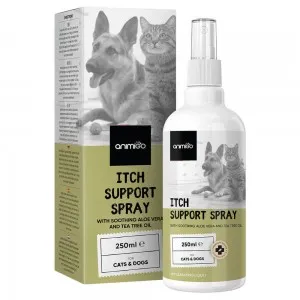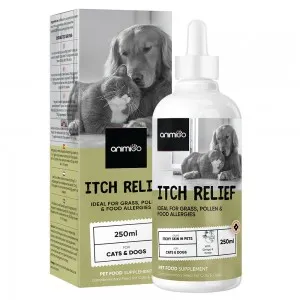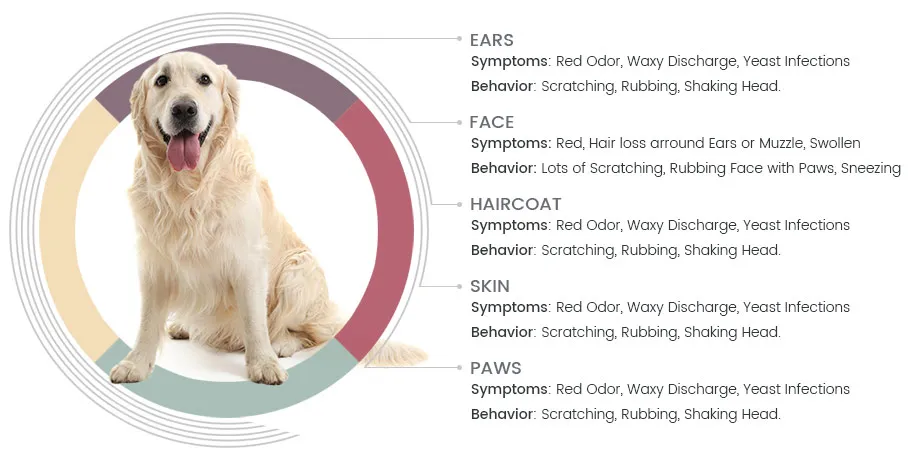100% Customer Satisfaction
Full 90-day money back guarantee
Free UK Delivery
Enjoy free shipping on orders above £30
Natural & Delicious Pet Supplements
Get nutritious, pet-safe & cruelty-free solutions
Filters
Dogs
When people think of dog allergies, a large portion think of people that are allergic to dogs. But did you know your dog can also have allergies of their own? Pet allergies are common amongst all types of animals, and can cause a number of issues both internally and externally in the same way as when a person has an allergy.
What are dog allergies?
An allergy is a reaction by the immune system to foreign substances that come into contact with the body. Your dog can potentially be allergic to a number of different things, including foods, shampoos, fleas, pollen and dust. An allergic reaction usually appears in a similar way to a human allergy, such as itching, vomiting or redness, but really depends on the specific dog. Whilst there is generally no cure for dog allergies, there are some ways to help. This can include avoiding the source of the allergy as much as possible, as well as giving them vet-recommended treatments and supplements that help their body deal with the invading foreign substance.
Which dogs are prone to allergies?
Dog allergies can develop in any breed and at any stage of their life, but it seems that for specific breeds, some are more prone to them than others. Skin allergic reactions have been seen to be more common in breeds such as Retrievers, Terriers and Setters whilst respiratory-related allergies that can affect breathing are found to be more common in flat-faced breeds such as Pugs, Bulldogs and Boston Terriers. This doesn't mean that if your dog’s breed isn’t part of that list they won’t get an allergy, but that they are predisposed and are more likely.
Dog allergy symptoms
Whilst the symptoms of dog allergies will vary depending on the dog, the allergy and its severity, there are some common symptoms to look out for. These include:
- Itching
- Red, irritated skin
- Scabbing skin
- Constant licking/scratching
- Biting the skin
- Diarrhoea
- Vomiting
- Avoiding certain foods
- Swelling
- Trouble breathing
- Heavy breathing
- Panting
- Runny nose
- Runny eyes
- Sneezing
- Abnormal snoring
How to identify dog allergies
You may think it is obvious that your dog has an allergy, as they will show symptoms. But how do you know if it is an allergy or something else? And how do you know what they’re allergic to? Some dog allergies are very clear - if they throw up straight after eating a specific food then it probably caused an issue for them. But if they’re starting to pant or breath more heavily, that could be an allergy but it could also be a result of increased exercise, hot weather or respiratory issues. If you are unsure if your dog has an allergy, the best way to be sure is to visit a vet. They can help you to distinguish if the symptoms are from an intolerance or another health issue.
So once you know your dog is allergic to something, how do you know what it is? This is again something that can be determined by your vet, or simply by taking notice of your pooch at home. Different dog allergies will have different signs. If it’s something like fleas, you will be able to see them. If you have changed their shampoo or are using new products around the house, this may be causing an allergic reaction in your dog. You may also be able to tell when giving them certain foods, or you can try swapping their regular foods to see if that gives a better result. Either way, it is going to take time and patience to pinpoint their allergies and is best to follow a systematic process of elimination.
Types of dog allergies
Allergies in dogs can generally be split into three groups - skin, food and environmental. These can cover a number of different intolerances, but usually have similar symptoms.
Dog skin allergies
There can be a number of different allergens that don’t agree with your dog’s skin. The most common is flea bites or flea saliva, also known as flea allergy dermatitis. These can be quite easy to spot yourself and there are plenty of home remedies and products to get rid of fleas at home. Other causes of dog skin allergies include chemicals on the skin, household products and dog cleaning products. Symptoms of these include red, itchy and inflamed skin as well as scabbing and scratching.
Dog food allergies
Just like with humans, dogs can also have allergies to certain foods. This will differ from pooch to pooch, and is not something that you can generalise. Most of these allergies will be from their food, with the most common being beef, chicken, corn, eggs, wheat, soy and milk. They can also be found in treats and in foods you feed them alongside their usual meals. When a dog has a food allergy, the most common symptoms are vomiting and diarrhoea as well as facial swelling.
Dog environmental allergies
Did you know dogs can also be allergic to things like pollen? Many think that environmental allergies such as pollen, dust and mould only occur in humans, but they can also affect your dog too. Some of these, such as mould, can be avoided by keeping the house and areas they live in clean, but allergens such as pollen can affect your dog for months and are usually seasonal. These environmental allergens can cause irritation around the paws and ears, but can also happen to any part of their body. They may also cause difficulty breathing and lead to sneezing and coughing.
Dealing with dog allergies
If your dog has an allergy, the best way to deal with it is to limit their exposure to the allergen. If there are specific foods they can’t handle then take them out of their diet. It is also important for dealing with many allergies that you make sure their living conditions are kept clean and tidy. For those that can’t be avoided though, the best option may be to find an appropriate canine allergy medication if it is serious. When looking for an allergy medication for dogs, it is best to ask your vet or a professional for advice instead of guessing.
If you don’t want to resort to medications though, a great choice is to try a natural dog allergy treatment that uses plant-based ingredients to boost the immune system and help them tackle the allergen from within. Foods that contain ingredients like vitamins, minerals and fatty acids can be great for the body overall, and useful for the immune system; foods and plants such as echinacea, pumpkin seeds and glucosamine are all beneficial. It is also said that coconut oil is a great natural dog skin allergy management, as it can help to soothe and calm irritation and redness.
In addition to this, there is also a wide range of dog food for dogs with allergies. These avoid common allergens such as wheat, eggs and milk and use natural, but still filling and nutritious, substitutes instead. You can also get tailored dog food for skin allergies, that avoid potential allergens as well as help to boost their immune system for a rounded dog allergy aid. Overall, although you may find your dog has a certain allergy that you need to deal with, there are plenty of things you can do to help them so they can live happily and healthily!






